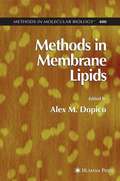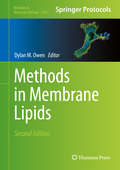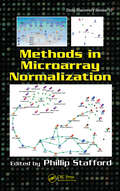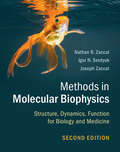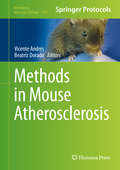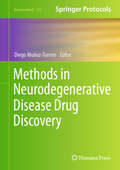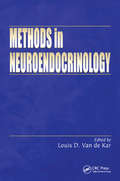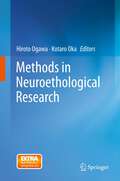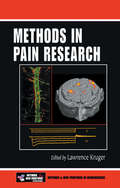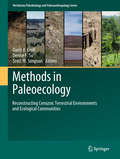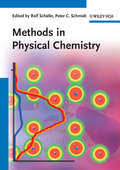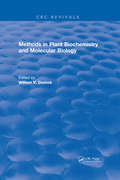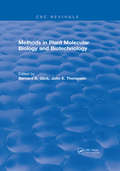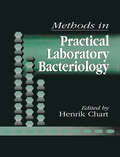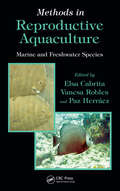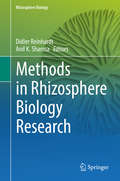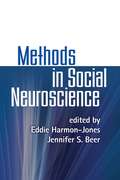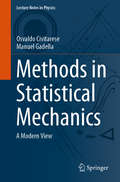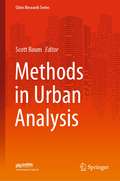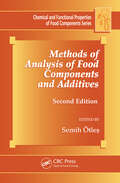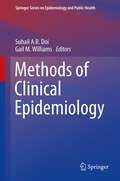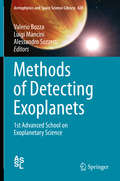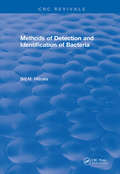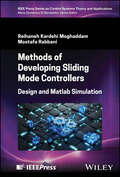- Table View
- List View
Methods in Membrane Lipids
by Alex DopicoThis book presents a compendium of methodologies for the study of membrane lipids, varying from traditional lab bench experimentation to computer simulation and theoretical models. The volume provides a comprehensive set of techniques for studying membrane lipids with a strong biophysical emphasis. It compares the various available techniques including the pros and cons as seen by the experts.
Methods in Membrane Lipids
by Dylan M. OwenThis volume expands upon the previous edition with current, detailed protocols for investigating membranes and their component lipids in artificial membranes, cells, and in silico. Chapters focus on properties of the component lipids, membranes and their biophysical properties, fluorescent probes for studying membranes, sample preparation, physical techniques to study membrane composition, properties , and function, behavior of cholesterol within a bilayer and examination of cholesterol-dependent phase separation. Written in the highly successful Methods in Molecular Biology series format, chapters include introductions to their respective topics, lists of the necessary materials and reagents, step-by-step, readily reproducible laboratory protocols, and tips on troubleshooting and avoiding known pitfalls. Authoritative and practical, Methods in Membrane Lipids, Second Edition seeks to aid scientist in further study into membrane lipids.
Methods in Microarray Normalization (Drug Discovery Series)
by Phillip StaffordThis organized text compiles, for the first time, the most useful normalization methods developed for interpreting microarray data. Experts examine the mathematical processes that are important in normalizing data and avoiding inherent systematic biases. They also review modern software, including discussions on key algorithms, comparative data, and download locations. The book contains the latest microarray innovations from companies such as Agilent, Affymetrix, and GeneGo as well as new, readily adaptable normalization methods for expression and CGH arrays. It also lists of open-source molecular profiling normalization algorithms available and where to access them.
Methods in Molecular Biophysics
by Igor N. Serdyuk Nathan R. Zaccai Joseph ZaccaiOur knowledge of biological macromolecules and their interactions is based on the application of physical methods, ranging from classical thermodynamics to recently developed techniques for the detection and manipulation of single molecules. These methods, which include mass spectrometry, hydrodynamics, microscopy, diffraction and crystallography, electron microscopy, molecular dynamics simulations, and nuclear magnetic resonance, are complementary; each has its specific advantages and limitations. Organised by method, this textbook provides descriptions and examples of applications for the key physical methods in modern biology. It is an invaluable resource for undergraduate and graduate students of molecular biophysics in science and medical schools, as well as research scientists looking for an introduction to techniques beyond their specialty. As appropriate for this interdisciplinary field, the book includes short asides to explain physics aspects to biologists and biology aspects to physicists.
Methods in Molecular Biophysics (2nd Edition): Structure, Dynamics, Function for Biology and Medicine
by Joseph Zaccai Nathan Zaccai Igor SerdyukOur knowledge of biological macromolecules and their interactions is based on the application of physical methods, ranging from classical thermodynamics to recently developed techniques for the detection and manipulation of single molecules. These methods, which include mass spectrometry, hydrodynamics, microscopy, diffraction and crystallography, electron microscopy, molecular dynamics simulations, and nuclear magnetic resonance, are complementary; each has its specific advantages and limitations. <P><P>Organised by method, this textbook provides descriptions and examples of applications for the key physical methods in modern biology. It is an invaluable resource for undergraduate and graduate students of molecular biophysics in science and medical schools, as well as research scientists looking for an introduction to techniques beyond their specialty. As appropriate for this interdisciplinary field, the book includes short asides to explain physics aspects to biologists and biology aspects to physicists.
Methods in Mouse Atherosclerosis
by Vicente Andrés Beatriz DoradoThis volume reviews available mouse models of atherosclerosis, basic aspects of disease initiation and progression, and the visualization of atherosclerotic lesions with invasive and non-invasive techniques that are widely used both in basic research and in the clinic. The chapters catalogue a wide range of in vitro and in vivo experimental methods used for atherosclerosis research, including thorough protocols and valuable notes based on the authors' personal wet lab experience. Written in the highly successful Methods in Molecular Biology series format, chapters include introductions to their respective topics, lists of the necessary materials and reagents, step-by-step, readily reproducible laboratory protocols, and key tips on troubleshooting and avoiding known pitfalls. Authoritative and practical, Methods in Mouse Atherosclerosis will be a valuable working guide for researchers performing mouse-based atherosclerosis studies.
Methods in Neurodegenerative Disease Drug Discovery (Neuromethods #216)
by Diego Muñoz-TorreroThis book explores the latest developments in the identification of biomarkers for early diagnosis of neurodegenerative diseases and methodologies for the biophysical; in vitro; cell-based; and in vivo profiling, during the early phases of drug discovery, new hits, leads, and drug candidates directed to a variety of biological targets with key pathogenic roles in neurodegenerative diseases. In the Neuromethods series style, chapters include the kind of detail and key advice from the specialists needed to get successful results in your laboratory. Comprehensive and thorough, Methods in Neurodegenerative Disease Drug Discovery offers practical guidance to researchers in the medicinal chemistry community. The methods described in this book can be readily implemented in many laboratories and will aid new and experienced researchers with creating future treatments for these devastating diseases.
Methods in Neuroendocrinology
by Louis D. Van de KarThis book describes some of the many different disciplines that are involved in investigations of neuroendocrine control mechanisms. It is intended for students, pre- and post-doctoral fellows, medical residents and others who are interested in neuroendocrine research.
Methods in Neuroethological Research
by Hiroto Ogawa Kotaro OkaThe rapid progress of neuroscience in the last decade can be largely attributed to significant advances in neuroethology, a branch of science that seeks to understand the neural basis of natural animal behavior. Novel approaches including molecular biological techniques, optical recording methods, functional anatomy, and informatics have brought drastic changes in how the neural systems underlying high-level behaviors such as learning and memory are described. This book introduces recent research techniques in neuroethology, with diverse topics involving nematodes, insects, and vertebrates (birds, mice and primates), divided into sections by research method. Each section consists of two chapters written by different authors who have developed their own unique approaches. Reports of research in "model animals" including C. elegans, Drosophila, and mice, which were not typical specimens in conventional neuroethology, have been deliberately selected for this book because a molecular genetic approach to these animals is necessary for advances in neuroethology. Novel methodology including optical recording and functional labeling with reporter genes such as GFP has been actively used in recent neurobiological studies, and genetic manipulation techniques such as optogenetics also are powerful tools for understanding the molecular basis of neural systems for animal behavior. This book provides not only these new strategies but also thought-provoking statements of philosophy in neuroethology for students and young researchers in the biological sciences.
Methods in Pain Research
by Lawrence KrugerIn the past two decades, pain research has become one of the most rapidly growing areas of neuroscience activity. Methods in Pain Research brings together in a single volume a survey of the methods that can be used to study a reaction or 'sensory report' in humans that can only be inferred by indirect means in animal or tissues studies. It presents
Methods in Paleoecology: Reconstructing Cenozoic Terrestrial Environments and Ecological Communities (Vertebrate Paleobiology and Paleoanthropology)
by Darin A. Croft Denise F. Su Scott W. SimpsonThis volume focuses on the reconstruction of past ecosystems and provides a comprehensive review of current techniques and their application in exemplar studies. The 18 chapters address a wide variety of topics that span vertebrate paleobiology and paleoecology (body mass, postcranial functional morphology, evolutionary dental morphology, microwear and mesowear, ecomorphology, mammal community structure analysis), contextual paleoenvironmental studies (paleosols and sedimentology, ichnofossils, pollen, phytoliths, plant macrofossils), and special techniques (bone microstructure, biomineral isotopes, inorganic isotopes, 3-D morphometrics, and ecometric modeling). A final chapter discusses how to integrate results of these studies with taphonomic data in order to more accurately characterize an ancient ecosystem. Current investigators, advanced undergraduates, and graduate students interested in the field of paleoecology will find this book immensely useful. The length and structure of the volume also makes it suitable for teaching a college-level course on reconstructing Cenozoic ecosystems.
Methods in Physical Chemistry
by Peter C. Schmidt Fer Rolf Sch AumlThanks to the progress made in instruments and techniques, the methods in physical chemistry have developed rapidly over the past few decades, making them increasingly valuable for scientists of many disciplines. These two must-have volumes meet the needs of the scientific community for a thorough overview of all the important methods currently used. As such, this work bridges the gap between standard textbooks and review articles, covering a large number of methods, as well as the motivation behind their use. A uniform approach is adopted throughout both volumes, while the critical comparison of the advantages and disadvantages of each method makes this a valuable reference for physical chemists and other scientists working with these techniques.
Methods in Plant Biochemistry and Molecular Biology
by William V. DashekModern plant science research currently integrates biochemistry and molecular biology. This book highlights recent trends in plant biotechnology and molecular genetics, serving as a working manual for scientists in academic, industrial, and federal laboratories. A wide variety of authors have contributed to this book, reflecting the thinking and expertise of active investigators who generate advances in technology. The authors were selected especially for their ability to create and/or implement novel research methods.
Methods in Plant Molecular Biology and Biotechnology
by Bernard R. GlickMethods in Plant Molecular Biology and Biotechnology emphasizes a variety of well-tested methods in plant molecular biology and biotechnology. For each detailed and tested protocol presented, a brief overview of the methodology is provided. This overview considers why the protocol is used, what other comparable methods are available, and what limitations can be expected with the protocol. Other chapters in the book present overviews regarding how to approach particular problems and introduce unique methods - such as how to use computer methodology to study isolated genes. The book will be a practical reference for plant physiologists, plant molecular biologists, phytopathologists, and microbiologists.
Methods in Practical Laboratory Bacteriology
by Henrik ChartThe success of laboratory experiments relies heavily on the technical ability of the bench scientist, with the aid of "tricks-of-the-trade", to generate consistent and reliable data. Regrettably, however, these invaluable "tricks-of-the-trade" are frequently omitted from scientific publications. This paucity of practical information relating to the conduct of laboratory bacteriology experiments creates a gaping void in the pertinent literature.Methods in Practical Laboratory Bacteriology fills this void. It provides detailed technical information that ensures that you achieve consistent and reliable data. The book addresses the aspects of bacterial fractionation and membrane characterization, the analysis of Lipopolysaccharides and the techniques of SDS-PAGE, immunoblotting, and ELISA. It also describes the methods used for detecting and quantifying bacterial resistance to antibiotics, and the analysis of bacterial chromosomes by pulsed-field gel electrophoresis (PFGE). Methods in Practical Laboratory Bacteriology also covers protocols for extracting the fingerprinting plasmids, as well as the use of non-radio labeled gene probes and ribosomal RNA gene probes.
Methods in Reproductive Aquaculture: Marine and Freshwater Species (CRC Marine Biology Series)
by Elsa Cabrita Vanesa Robles Paz HerráezThe large amount of information on fish reproduction available is not always readily accessible to all interested parties. Written to appeal to aquaculturalists, conservation managers, and scientific researchers, Methods in Reproductive Aquaculture provides an overview of available techniques and addresses ways to improve depleted stocks of endange
Methods in Rhizosphere Biology Research (Rhizosphere Biology)
by Anil K. Sharma Didier ReinhardtThis book compiles various methodologies used in understanding interactions within the rhizosphere. An in-depth understanding of the rhizosphere is essential to developing successful strategies for future sustainable agriculture. The book summarizes methods and techniques used to study the mechanisms involved in mutualistic symbioses and pathogenic interactions of plants with various microbial organisms including fungi, bacteria, and oomycetes. Each chapter discusses different methodologies used in rhizosphere biology, while also providing real-world experimental data and trouble-shooting tips. Interested researchers will also find a wealth of literature references for further research. As the first comprehensive manual and compilation of methods and techniques used in rhizosphere biology, the book represents an essential resource for all researchers who are newcomers to soil microbiology experimentation.
Methods in Social Neuroscience
by Jennifer S. Beer Eddie Harmon-JonesStraightforward and practical, this is the first book to provide detailed guidance for using neurobiological methods in the study of human social behavior, personality, and affect. Each chapter clearly introduces the method at hand, provides examples of the method's applications, discusses its strengths and limitations, and reviews concrete experimental design considerations. Written by acknowledged experts, chapters cover neuroimaging techniques, genetic measurement, hormonal methods, lesion studies, startle eyeblink responses, facial electromyography, autonomic nervous system responses, and modeling based on neural networks.
Methods in Statistical Mechanics: A Modern View (Lecture Notes in Physics #974)
by Osvaldo Civitarese Manuel GadellaThis book presents a variety of techniques for tackling phenomena that are not amenable to the conventional approach based on the concept of probabilities. The methods described rely on the use of path integration, thermal Green functions, time-temperature propagators, Liouville operators, second quantization, and field correlators at finite density and temperature. Also exploring the statistical mechanics of unstable quantum systems, the book is intended as a supplementary or reference text for use in one-semester graduate courses on Quantum Mechanics, Thermodynamics, Electromagnetism, and Mathematical Methods in Physics.
Methods in Urban Analysis (Cities Research Series)
by Scott BaumThis book highlights major quantitative and qualitative methods and approaches used in the field of urban analysis. The respective chapters cover the background and relevance of various approaches to urban studies and offer guidance on implementing specific methodologies. Each chapter also provides links to real-world examples. The book is unique in its focus on Australian examples and subject matter, presented by recognized experts in the field.
Methods of Analysis of Food Components and Additives (Chemical & Functional Properties of Food Components)
by Semih ÖtleşWith diet, health, and food safety news making headlines on a regular basis, the ability to separate, identify, and analyze the nutrients, additives, and toxicological compounds found in food and food components is more important than ever. This requires proper training in the application of best methods, as well as efforts to improve existing meth
Methods of Clinical Epidemiology
by Gail M. Williams Suhail A. Doi"Methods of Clinical Epidemiology" serves as a text on methods useful to clinical researchers. It provides a clear introduction to the common research methodology specific to clinical research for both students and researchers. This book sets out to fill the gap left by texts that concentrate on public health epidemiology and focuses on what is not covered well in such texts. The four sections cover methods that have not previously been brought together in one text and serves as a second level textbook of clinical epidemiology methodology. This book will be of use to postgraduate students in clinical epidemiology as well as clinical researchers at the start of their careers.
Methods of Detecting Exoplanets
by Valerio Bozza Luigi Mancini Alessandro SozzettiIn this book, renowned scientists describe the various techniques used to detect and characterize extrasolar planets, or exoplanets, with a view to unveiling the "tricks of the trade" of planet detection to a wider community. The radial velocity method, transit method, microlensing method, and direct imaging method are all clearly explained, drawing attention to their advantages and limitations and highlighting the complementary roles that they can play in improving the characterization of exoplanets' physical and orbital properties. By probing the planetary frequency at different distances and in different conditions, these techniques are helping astrophysicists to reconstruct the scenarios of planetary formation and to give robust scientific answers to questions regarding the frequency of potentially habitable worlds. Twenty years have passed since the discovery of a Jupiter-mass companion to a main sequence star other than the Sun, heralding the birth of extrasolar planetary research; this book fully conveys the exciting progress that has been achieved during the intervening period.
Methods of Detection and Identification of Bacteria (CRC Press Revivals)
by B. M. MitrukaThe objective of this book is to present a critical review and evaluation of the so-called conventional methods currently being used for bacterial identification, as well as to discuss the new approaches for the detection and identification of bacteria. Morphological, biochemical, and serological methods of detection and identification of bacteria in clinical specimens are emphasised, and current methods of characterization and enumeration of bacteria in air, water, milk, and other food materials are also described.
Methods of Developing Sliding Mode Controllers: Design and Matlab Simulation (IEEE Press Series on Control Systems Theory and Applications)
by Reihaneh Kardehi Moghaddam Mostafa RabbaniComprehensive, fast-access guide to different types of sliding mode controllers and their programming and simulation in MATLAB and Simulink Methods of Developing Sliding Mode Controllers delivers a practical review of sliding mode controllers (SMCs) and their challenges with coverage of related theorems, stability analysis, and how to program and simulate SMCs in MATLAB and Simulink. The book details the latest methods of their development and their applications in the automotive, aerospace, and robotics industries. Initial chapters detail a range of different types of controllers. A combination of sliding and backstepping control is introduced and simulated and the phenomenon of chattering and effective solutions to reduce it are provided, along with suitable examples and analytical tables of the results. The final two chapters are related to fixed-time and event-triggered SMCs. Extensive Matlab/Simulink supported examples and simulation program code/block diagrams are included throughout. Methods of Developing Sliding Mode Controllers: Design and Matlab Simulation explores sample topics including: Classic SMCs, covering variable structures, including relays and feedback control with switching gains, as well as controller design and theoretical foundations Terminal SMCs, covering nonsingular and fast variations, dynamic SMCs, and fuzzy SMCs, covering fuzzy approximation and equivalent control as well as indirect design Super twisting SMCs, adaptive SMCs, and backstepping SMCs, covering the backstepping method and chaotic duffing oscillator equations Sign, Epsilon-sign, saturation, hyperbolic tangent, and generalized hyperbolic tangent functions for chatter reduction Methods of Developing Sliding Mode Controllers: Design and Matlab Simulation is a concise yet comprehensive and highly practical reference on the subject for graduate/postgraduate students in electrical engineering, mechanical engineering, and biomedical engineering along with academics and professionals in fields related to SMCs.
